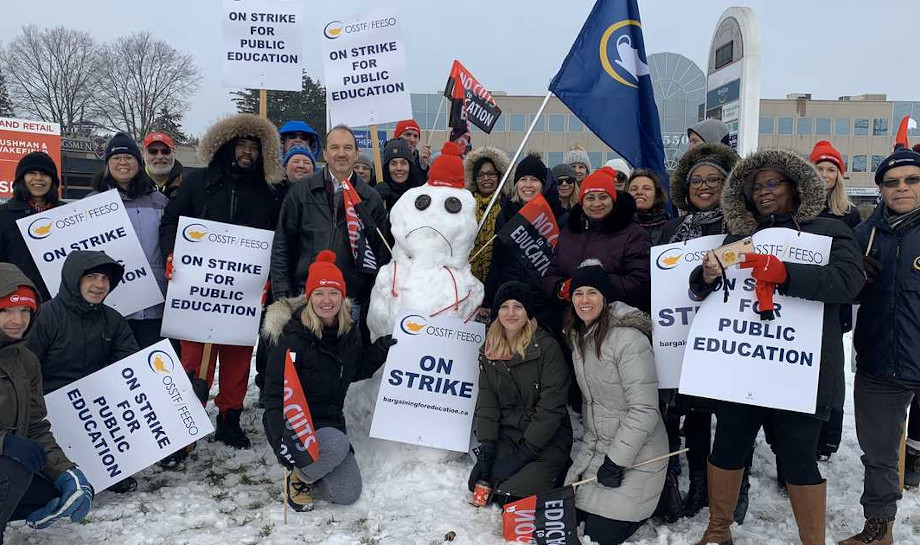Tim Heffernan is retired Ontario Teacher and OSSTF activist.
Wednesday, December 4, saw the first provincial strike of teachers since 1997. 60,000 High School teachers and education workers walked off the job for the day and picketed outside schools, Board offices and the offices of Tory MPPs. For 2 weeks prior to this, the union, with the backing of a 95% strike vote, had conducted a work to rule (affecting administrative tasks rather than impacting classroom or extracurricular activities). The work to rule had no effect on moving the government and so the union, Ontario Secondary School Teachers’ Federation (OSSTF), called the one day strike. In terms of getting public support, building solidarity and a sense of oneness among the teachers, the strike was a tremendous success:
This was the report in a teachers’ Facebook group from one union Branch President (shop steward):
“This day was excellent. The resolve was phenomenal. The staff at my school are PUMPED. They know the issues, they are informed, they are ready to talk to the media, to parents. Our admin were on the line with us at different points. Our CUPE support staff brought us water, coffee, snacks, donuts. We had musical instruments, we had homemade signs, we had hand warmers, and tarps for our bags, lawn chairs for breaks, and in 4 hours one middle finger, one shaken head, and one thumb down. The rest was so so much love (and our school is not on a main road and only somewhat off the beaten path).
“Today was worthwhile. We had teachers, retired teachers, who wore their “classic” OSSTF hats, who were on strike for 37 days in 1975 come and visit us and tell us to hang in there and that our fight is important. It is.
“This is a day we needed. It was awesome. I find it hard to believe that NOTHING will come of this. The will for the fight is getting stronger, and so is the support from the public.”
For some months, a head of steam has been building up among teachers and education workers in Ontario, focused on the cuts to education (per pupil funding and elimination of jobs) by the Ford government. Education Minister Lecce has claimed that the government is spending more on education than any government previously, yet calculations show the government’s education spending per-pupil for 2019-20 is $54 lower than in the previous year.
According to Ontario’s Financial Accountability Office, the Ford government’s original proposed changes to school staffing (achieved by increasing class size) would, over five years, reduce the number of teachers employed in the province by 10,054. Starting off with the proposal to increase class size to 28 (from the existing 22), the government softened its proposal in high schools to 25 students per class, without altering its target for elementary schools. Researchers noted that this would still remove about 6,000 teaching positions from Ontario’s schools, over several years. This slashing of teachers and increasing of class sizes will have a negative impact on students’ learning.
Another contentious issue was that of mandatory on line courses for High School students. Originally, the government proposed 4 classes (4 times more than any other North American jurisdiction having mandatory e-courses). It was suspected that the introduction of this type of course was for cost cutting reasons, especially if class caps were removed. During negotiations, the government reduced the number to 2 mandatory classes.
Money is the final sticking point. The union is arguing for a 2% increase, keeping pace with the cost of living, to compensate for pay having fallen around 8% behind the rate of inflation over the past 7 years. The government position is that other public sector wage increases have been capped at 1% with the adoption of Bill 124, which was passed in a bid to help trim the provincial deficit. Naturally, they don’t want to make an exception for teachers.
It became apparent, over the summer and during the federal election, that Ford’s popularity has plummeted dramatically. Faced with this situation, Ford and his Education Minister have back-pedalled on some of the most extreme positions. Despite the backtracking and “concessions”, the government is losing the war for hearts and minds, i.e. public opinion. Lecce has acknowledged that the government spent “just shy” of $1 million consulting parents about its changes to public education, including its planned class size increases. But, when asked what response the government received, the minister declined to comment. He said only that releasing the data could “directly impinge our negotiating position” at the bargaining table. According to a recent poll, only 11% of Ontarians support larger class sizes. And on the streets, the massive honking of horns, the thumbs up and the supportive conversations demonstrate that the public support is real.
What next?
The one day strike has not shifted the Ford government. The OSSTF has announced a further one day strike on December 11, in some school districts. It is possible that the solid support of teachers and public for these partial actions, will be sufficient to move the government. After all, Doug Ford, of late, has become sensitive to his public image. On the other hand, the union may well have to use stronger action to move the government, particularly on the issue of pay. The question is posed of raising the bar to rotating strikes and/or an all out indefinite strike. That, of course, raises the likelihood of the government introducing back to work legislation. The big question – does the union leadership have a plan B for that eventuality?
If OSSTF is going to successfully deal with this issue, it is essential to have a co-ordinated strategy with the other education unions covering elementary teachers and those in the Catholic and francophone boards of education. All the unions covering these teachers have already taken strike votes, getting support around the 95% mark but have not yet launched strike action. But even an all round, consolidated and integrated union action may not be enough as the 1997 political protest against the Mike Harris government demonstrated. In anticipation of a government plan to bring in back to work legislation in the event of an all out strike, approaches need to be made now to the Ontario Federation of Labour with a view to getting commitments from the wider labour movement for solidarity action.
The teachers are fighting a just cause and they have the public on their side. Using a bold and astute strategy, they could be making a major stand in defence of public education while, at the same time, inflicting a fatal blow to the Ford government.




